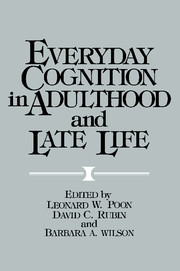Book contents
- Frontmatter
- Contents
- List of contributors
- Preface
- Part I Adult cognitive abilities in the laboratory and in real-life settings: Basic theoretical and methodological issues
- 1 Introduction to Part I: The how, when, and why of studying everyday cognition
- Part IA Systematic approaches to laboratory and real-world research
- Part IB Combining laboratory and real-world research
- Part II Cognition in adulthood and late life: Findings in real-life settings
- Part IIA Everyday cognitive abilities
- Part IIB Concomitant influences
- Part III Cognitive enhancement and aging: Clinical and educational applications
- Part IIIA Issues and perspectives
- Part IIIB Enhancement approaches
- Part IIIC Designing programs for cognitive rehabilitation
- Subject index
- Author index
1 - Introduction to Part I: The how, when, and why of studying everyday cognition
Published online by Cambridge University Press: 05 October 2013
- Frontmatter
- Contents
- List of contributors
- Preface
- Part I Adult cognitive abilities in the laboratory and in real-life settings: Basic theoretical and methodological issues
- 1 Introduction to Part I: The how, when, and why of studying everyday cognition
- Part IA Systematic approaches to laboratory and real-world research
- Part IB Combining laboratory and real-world research
- Part II Cognition in adulthood and late life: Findings in real-life settings
- Part IIA Everyday cognitive abilities
- Part IIB Concomitant influences
- Part III Cognitive enhancement and aging: Clinical and educational applications
- Part IIIA Issues and perspectives
- Part IIIB Enhancement approaches
- Part IIIC Designing programs for cognitive rehabilitation
- Subject index
- Author index
Summary
As a scientific enterprise, the study of memory is relatively new and fairly successful. The methods set out by Ebbinghaus only a century ago are adequate to demonstrate that the psychological study of memory can be scientific. As we progress and try to demonstrate that psychology can also increase our practical and theoretical understandings, Ebbinghaus's laboratory methods often seem insufficient. Our own progress and confidence have led us to broaden the research we do.
One aspect of this progress has been the call for cognitive and experimental psychologists to move out of the laboratory. Recent examples include this book, Neisser's attacks on the kind of laboratory studies he carried out in 1967, numerous American Psychologist articles on basic methodological issues, and even the “Call for Papers” of the Psychonomic Society. Possibly independent of all of this, academic and research psychologists are spending a greater proportion of their time studying practical, complex, real-world problems in the name of science. Is this really a good idea, or just the latest fad? Psychology is fond of the theory of pendulum swings. Can a little forethought dampen the pendulum?
Part I of this book provides a rationale, or, more accurately, a set of rationales, for studying cognition in the “real world” rather than in the laboratory. Unlike Parts II and III, Part I does not provide reviews of the literature, but rather provides arguments for pursuing science in various ways.
Information
- Type
- Chapter
- Information
- Everyday Cognition in Adulthood and Late Life , pp. 3 - 8Publisher: Cambridge University PressPrint publication year: 1989
Accessibility standard: Unknown
- 1
- Cited by
